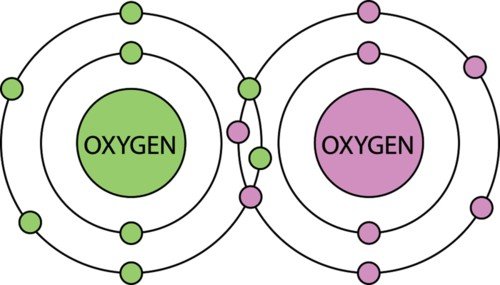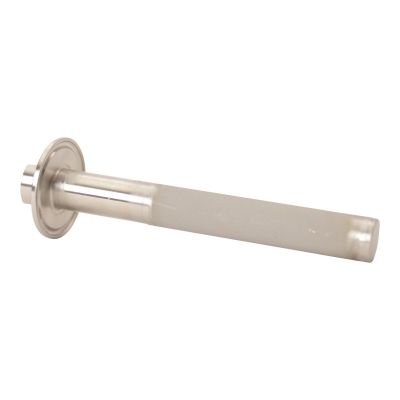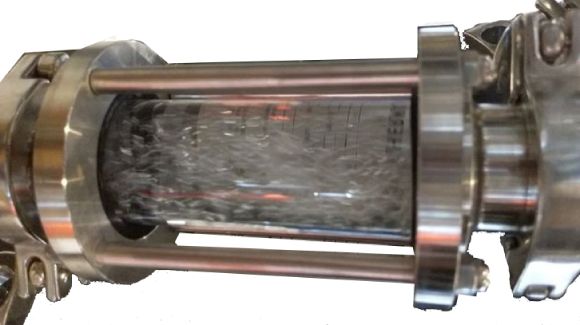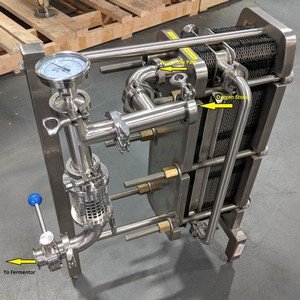Proudly Serving Our Customers
See All ReviewsWort Aeration - A Comprehensive Yeast Oxygenation Guide
How to Optimize Yeast Health for Efficient Beer Production
The Oxygen Dilemma

Oxygen, the life-giving molecule of beer-loving and non beer-loving mammals alike is the kryptonite of the fermented brew itself. A decreased shelf-life and stale flavors are clear indicators your beer is suffering a dioxide (O2) overdose. Fortunately, most of the oxygen is removed from the production process when the wort is boiled. Unfortunately, yeast is very dependent on oxygen to create the unsaturated fatty acids and sterols that make up its cell walls, and most importantly reproduce. Without it the yeast membrane will have poorer permeability with a lower tolerance to higher levels of alcohol, while a healthy membrane means better attenuation, more complete and faster fermentation, a lower chance of a stuck fermentation, and more consistent flavors.
The Master Brewer's Solution
Fortunately, there's no reason to wave the white flag, and you can build a solution from a handful of parts available at Glacier Tanks. To achieve optimum yeast health we simply need to lightly aerate (add oxygen) our wort prior to pumping it to the fermentor, where we will then pitch the yeast. While there are a number of methods to achieve the desired result, we believe the inline oxygen stone is by far the best commercial solution available. Alternatives include agitation by either spraying beer into the fermentor or pre-agitation, however these have higher risks of negative effects on the beer and are less accurate than using pure oxygen and an inline carbonation stone. Regardless, the most important component is to be aware that oxygen is more easily absorbed with a cooler wort temperature, and as such, we want to make sure we start our oxygenation process after the heat exchanger. Let's dive in...
Required Materials

Oxygen Stone: The most important part in the oxygenation setup is the oxygen stone. At Glacier Tanks we offer a dual use stone (carbonation or oxygen) with a 2 micron porosity. Oxygen stones are most effective from 0.5 to 3 microns. Any smaller and the stone becomes clogged too easily by proteins and organic material, any higher and the bubbles are too large and won't dissolve into the solution as well, resulting in more oxygen being wasted. In most cases the 4 inch carbonation stone (CBST-R150-004) will work the best as it fits the easiest into the system and delivers oxygen at a consistent rate with an optimum amount of surface area. This is a sintered stone with a 1.5" Tri Clamp connection made of SS316. In cases with larger systems over 30bbl's sometimes a 6 inch (CBST-R150-006), 8 inch (CBST-R150-008), or the larger 12 inch (CBST-R150-012) stone may be required to ensure optimal aeration.
Oxygen Source: It is highly recommended to use compressed oxygen tanks. Using compressed air even with a filter still has a chance of adding contaminants to the wort and is far less efficient than using compressed oxygen. Compressed air is usually only around 20% oxygen, while compressed oxygen is certified at its lowest grade to be around 90% or higher. Medical grade oxygen is not necessary as that rating only reflects the chain of custody of the vessel and has is not a certification of the actual oxygen gas itself.
Oxygen Regulator: The best regulators allow adjusting the flow of oxygen in Liters Per Minute (LPM), and most oxygen regulators range from 0-15 LPM with some being more accurate at lower volumes. Ensure that the regulator is specifically calibrated for oxygen and not just a generic flow meter.
Oxygenation Stone Installation
When knocking down, temperature control is the most important factor. Starting the wort at the optimum temperature for the yeast will allow for the fermentation to begin and end as efficiently as possible. A cooler wort absorbs oxygen more effectively, and thus, the oxygen system is usually placed after the heat exchanger, but before the thermometer and sight glass. This way you can see the actual temperature of the wort as it is leaving the unit and also make sure that your adequately adding oxygen throughout the knock down, while keeping the agitation (where oxygen is escaping) to a minimum. Depending on the space you have surrounding the heat exchanger there are multiple orientations for the oxygen system. The image below represents the simplest setup but there are other options depending on how the heat exchanger is laid out in the system.
We used the following Tri Clamp fittings with this heat exchanger:
Operation

Once the parts are installed and the pathway is setup, start your knock down by first flowing cold water through the cooling side of the heat exchanger. Once the cold side is flowing start your wort pump. If the heat exchanger is filled with a sanitizing fluid, make sure you purge your system before filling the heat exchanger with wort. Once wort passes through the sight glass check the temperature gauge and ensure this is the proper temperature for the yeast you're using, increase the pump speed or water flow to adjust the wort temp to a proper range. Once the temperature is correct you can turn on the oxygen and set it to the proper liters per minute, approximately 0.5 - 1 LPM. You should see a fine swirl of bubbles running through the sight glass. Once knock down is complete, we need to clean the entire system. First, turn off the oxygen flow so you don't pressurize the heat exchanger. After that, remove your oxygen stone and soak it in alcohol or caustic solution. Seal the opening from the removed stone with an end cap, and clean-in-place (CIP) the rest of the unit as normal.
Calculating Oxygen Levels
Once you have an oxygen source and a regulator you'll have the most control of gas delivery to establish your dissolved oxygen (DO) levels. However, while there are a few methods to calculate your total DO, to get a truly accurate reading we highly recommend the use of a meter. Additionally, each strain of yeast and the specific cell counts of the pitch will have a great effect on the required amount of oxygen for optimum fermentation. Generally, the target is to have between 8-10 parts per million (ppm) of dissolved oxygen in the wort and the simplest way to ensure this is to record your LPM of oxygen, GPM of wort and the time your knock down takes, measure with a DO meter (these can be rented or sometimes borrowed from a larger brewery). Once you have the dissolved oxygen content of the wort you can then increase or decrease the LPM of oxygen supplied until they are at the correct levels for your fermentation needs.
Due to the extremely wide variance in brewing systems there really is no "standard" amount of oxygen delivery. In the simplest scenario you can add oxygen during knock down and track your fermentations and slowly increase oxygen delivery with each new brew until you see improved results in fermentation times. Proper oxygen levels in wort can increase yeast viability for multiple generations as well as reduce fermentation time by up to 48 hours.

